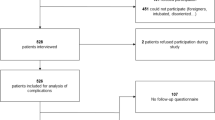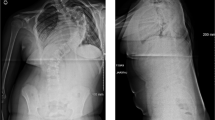Abstract
Papilledema, is a known complication of various spinal pathologies. It has, however, been only infrequently reported following spinal injury, and may be overlooked in these cases. Presented herein is a 27 year old male who suffered thoracic and lumbar spinal injuries. Papilledema following mild increase in intracranial pressure (IICP) developed 3 weeks following trauma, and subsided within 8 weeks. The importance of routine repeat ophthalmoscopic examinations following spinal injury to detect changes characteristic of IICP is emphasised.
Similar content being viewed by others
Log in or create a free account to read this content
Gain free access to this article, as well as selected content from this journal and more on nature.com
or
References
Tanaka K, Waga S, Shimoshaka S (1988) Papilledema and spinal cord tumors. Surg Neurol 29: 462–466.
Toulemonde V, Labrune P, Sainte Rose C, Odievre M (1989) Intermittent intracranial hypertension revealing a tumor of the cervical spine. Arch Fr Pediatr 46: 667–669.
Purohit A K, Dinakar I, Sundaram C, Ratankar K S (1990) Anaplastic astrocytoma of the spinal cord presenting with features of raised intracranial pressure. Child Nerv Syst 6: 113–115.
Firsching R, Richard K E, Thun F (1988) Acute hydrocephalus in infectious spinal disorder. Neurosurg Rev 11: 103–105.
Hahn F J Y, Rim K (1976) Frontal ventricular dimensions on normal computed tomography. Am J Roentg 126: 593–596.
Duke-Elder S (1971) System of Ophthalmology. Henry Kimpton, London: 60–65.
Hayreh S S (1964) Pathogenesis of oedema of the optic disc (papilledema). Br J Ophthalmol 48: 522–543.
Minckler D S, Tso M O M, Zimmerman L E (1976) A light microscopic autoradiographic study of axoplasmic flow in the optic nerve head during ocular hypotony, increased intraocular pressure and papilledema. Am J Ophthalmol 82: 741–757.
Tso M O M, Hayreh S S (1977) Optic disc edema in raised intracranial pressure. IV: Axoplasmic transport in experimental papilledema. Arch Ophthalmol 95: 1458–1462.
Adams R D, Victor M (1985) Disturbances of cerebrospinal fluid circulation, including hydrocephalus and meningeal reactions. In: Principles of Neurology. McGraw-Hill, Singapore: 461–473.
Cole J D . The pathophysiology of the autonomic nervous system in spinal cord injury. In: Illis LS, editor. Spinal Cord Dysfunction: Assessment. Oxford University Press, Oxford: 201–235.
Edvinsson L (1982) Sympathetic control of cerebral circulation. Trends Neurosci 5: 425–429.
Selhorst J B, Gudeman S K, Butterworth J F, Harbison J W, Miller J D, Becker D P (1985) Papilledema after acute head injury. Neurosurgery 16: 357–363.
Jennett B, Teasdale G (1981) Management of Head Injuries. FA Davis Company, Philadelphia: 19–43.
Reider-Grosswasser I (1991) Late CT findings in traumatic brain injury. I: Linear measurements. The International Brain Injury Symposium, New Orleans, USA, 1991.
Author information
Authors and Affiliations
Rights and permissions
About this article
Cite this article
Catz, A., Appel, I., Reider-Grosswasser, I. et al. Late-onset papilledema following spinal injury. Case report. Spinal Cord 31, 131–135 (1993). https://doi.org/10.1038/sc.1993.24
Issue date:
DOI: https://doi.org/10.1038/sc.1993.24
Keywords
This article is cited by
-
Spinal injuries in the pediatric age group: a review of 82 cases of spinal cord and vertebral column injuries
European Spine Journal (1996)



